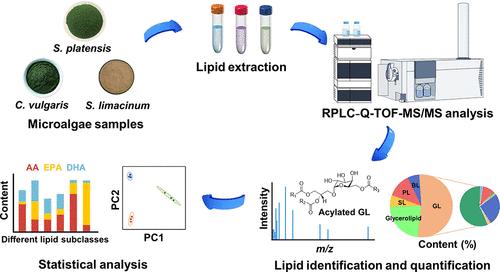当前位置:
X-MOL 学术
›
J. Agric. Food Chem.
›
论文详情
Our official English website, www.x-mol.net, welcomes your feedback! (Note: you will need to create a separate account there.)
Comprehensive Lipidomic Analysis of Three Edible Microalgae Species Based on RPLC–Q-TOF-MS/MS
Journal of Agricultural and Food Chemistry ( IF 5.7 ) Pub Date : 2024-07-18 , DOI: 10.1021/acs.jafc.4c01897 Xinyu Cao 1 , Peixu Cong 1 , Yu Song 1 , Nan Meng 1 , Xiaowei Fan 1 , Yanjun Liu 1 , Xiaoxu Wang 1 , Jie Xu 1 , Changhu Xue 1, 2
Journal of Agricultural and Food Chemistry ( IF 5.7 ) Pub Date : 2024-07-18 , DOI: 10.1021/acs.jafc.4c01897 Xinyu Cao 1 , Peixu Cong 1 , Yu Song 1 , Nan Meng 1 , Xiaowei Fan 1 , Yanjun Liu 1 , Xiaoxu Wang 1 , Jie Xu 1 , Changhu Xue 1, 2
Affiliation

|
Microalgae, integral to marine ecosystems for their rich nutrient content, notably lipids and proteins, were investigated by using reversed-phase liquid chromatography coupled with quadrupole time-of-flight mass spectrometry (RPLC–Q-TOF-MS/MS). This study focused on lipid composition in three commonly used microalgae species (Spirulina platensis, Chlorella vulgaris, and Schizochytrium limacinum) for functional food applications. The analysis unveiled more than 700 lipid molecular species, including glycolipids (GLs), phospholipids (PLs), sphingolipids (SLs), glycerolipids, and betaine lipids (BLs). GLs (19.9–64.8%) and glycerolipids (24.1–70.4%) comprised the primary lipid. Some novel lipid content, such as acylated monogalactosyldiacylglycerols (acMGDG) and acylated digalactosyldiacylglycerols (acDGDG), ranged from 0.62 to 9.68%. The analysis revealed substantial GLs, PLs, and glycerolipid variations across microalgae species. Notably, S. platensis and C. vulgaris displayed a predominance of fatty acid (FA) 18:2 and FA 18:3 in GLs, while S. limacinum exhibited a prevalence of FA 16:0, collectively constituting over 60% of the FAs of GLs. In terms of PLs and glycerolipids, S. platensis and C. vulgaris displayed elevated levels of arachidonic acid (AA) and eicosapentaenoic acid (EPA), whereas S. limacinum exhibited a significant presence of docosahexaenoic acid (DHA). Principal component analysis (PCA) revealed MGDG (16:0/18:1), DG (16:0/22:5), Cer (d18:1/20:0), and LPC (16:1) as promising lipid markers for discriminating between these microalgae samples. This study contributes to a comprehensive understanding of lipid profiles in three microalgae species, emphasizing their distinct biochemical characteristics and potentially informing us of their high-value utilization in the food industry.
中文翻译:

基于 RPLC–Q-TOF-MS/MS 的三种食用微藻的综合脂质组学分析
微藻因其丰富的营养成分(尤其是脂质和蛋白质)而成为海洋生态系统不可或缺的组成部分,通过反相液相色谱与四极杆飞行时间质谱联用 (RPLC–Q-TOF-MS/MS) 对微藻进行了研究。本研究重点关注用于功能性食品应用的三种常用微藻物种(钝顶螺旋藻、普通小球藻和裂殖壶菌)的脂质组成。该分析揭示了 700 多种脂质分子种类,包括糖脂 (GL)、磷脂 (PL)、鞘脂 (SL)、甘油脂和甜菜碱脂质 (BL)。 GL(19.9-64.8%)和甘油脂(24.1-70.4%)构成主要脂质。一些新的脂质含量,例如酰化单半乳糖二酰甘油 (acMGDG) 和酰化二半乳糖二酰甘油 (acDGDG),范围为 0.62% 至 9.68%。分析揭示了微藻物种之间的 GL、PL 和甘油脂存在显着差异。值得注意的是,钝顶链球菌和普通念珠菌在 GL 中以脂肪酸 (FA) 18:2 和 FA 18:3 为主,而 S. limacinum 则以 FA 16:0 为主,合计占 FA 的 60% 以上GL。就 PL 和甘油脂而言,钝顶链球菌和普通念珠菌的花生四烯酸 (AA) 和二十碳五烯酸 (EPA) 水平较高,而 S. limacinum 则显示出显着存在的二十二碳六烯酸 (DHA)。主成分分析 (PCA) 显示 MGDG (16:0/18:1)、DG (16:0/22:5)、Cer (d18:1/20:0) 和 LPC (16:1) 是有前途的脂质用于区分这些微藻样品的标记。 这项研究有助于全面了解三种微藻物种的脂质谱,强调它们独特的生化特征,并有可能让我们了解它们在食品工业中的高价值利用。
更新日期:2024-07-23
中文翻译:

基于 RPLC–Q-TOF-MS/MS 的三种食用微藻的综合脂质组学分析
微藻因其丰富的营养成分(尤其是脂质和蛋白质)而成为海洋生态系统不可或缺的组成部分,通过反相液相色谱与四极杆飞行时间质谱联用 (RPLC–Q-TOF-MS/MS) 对微藻进行了研究。本研究重点关注用于功能性食品应用的三种常用微藻物种(钝顶螺旋藻、普通小球藻和裂殖壶菌)的脂质组成。该分析揭示了 700 多种脂质分子种类,包括糖脂 (GL)、磷脂 (PL)、鞘脂 (SL)、甘油脂和甜菜碱脂质 (BL)。 GL(19.9-64.8%)和甘油脂(24.1-70.4%)构成主要脂质。一些新的脂质含量,例如酰化单半乳糖二酰甘油 (acMGDG) 和酰化二半乳糖二酰甘油 (acDGDG),范围为 0.62% 至 9.68%。分析揭示了微藻物种之间的 GL、PL 和甘油脂存在显着差异。值得注意的是,钝顶链球菌和普通念珠菌在 GL 中以脂肪酸 (FA) 18:2 和 FA 18:3 为主,而 S. limacinum 则以 FA 16:0 为主,合计占 FA 的 60% 以上GL。就 PL 和甘油脂而言,钝顶链球菌和普通念珠菌的花生四烯酸 (AA) 和二十碳五烯酸 (EPA) 水平较高,而 S. limacinum 则显示出显着存在的二十二碳六烯酸 (DHA)。主成分分析 (PCA) 显示 MGDG (16:0/18:1)、DG (16:0/22:5)、Cer (d18:1/20:0) 和 LPC (16:1) 是有前途的脂质用于区分这些微藻样品的标记。 这项研究有助于全面了解三种微藻物种的脂质谱,强调它们独特的生化特征,并有可能让我们了解它们在食品工业中的高价值利用。












































 京公网安备 11010802027423号
京公网安备 11010802027423号